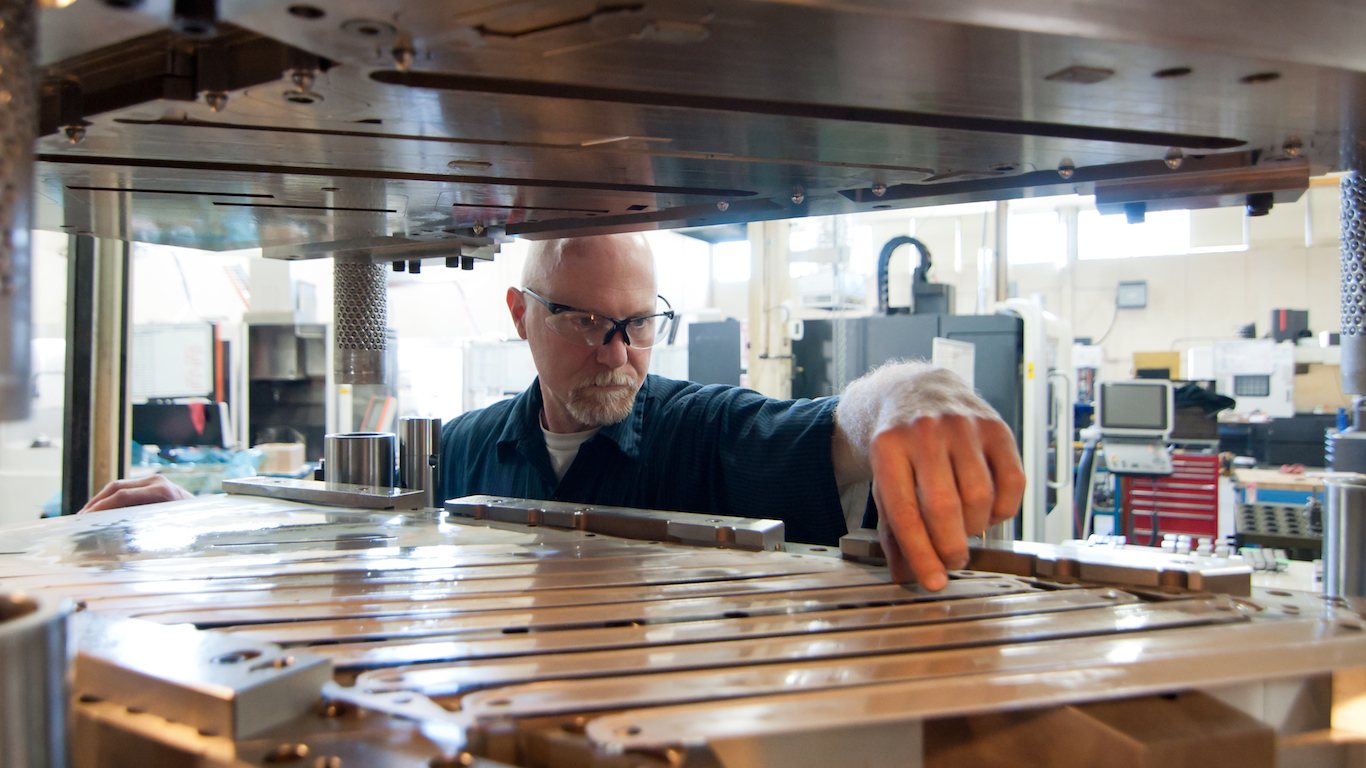
Since the beginning of the 21st century, millions of U.S. jobs have been displaced or eliminated due to cheaper foreign labor. Trade balance changes in China alone have displaced over 3 million jobs in roughly the last 15 years, the majority of which were in the manufacturing sector. According to projections from the Bureau of Labor Statistics, many more jobs are going to be lost to outsourcing and offshoring in the coming years.
Based on BLS projections of overall employment change by occupation between 2014 and 2024, 24/7 Wall St. identified the 12 jobs that will shed more than 10% of their workforce due, at least in part, to foreign labor. In keeping with historical patterns, manufacturing jobs are the most likely to be outsourced in the coming years.
[in-text-ad]
Even as labor costs in countries such as China are on the rise, they remain lower than in the United States. In China, labor costs 5% less, according to research conducted by management consulting firm Boston Consulting Group. With companies citing lower labor costs as the primary reason for moving jobs outside of U.S. borders, they will likely continue this move in the foreseeable future.
Click here to see the 12 jobs being lost to China.
Most jobs at risk of being outsourced are low-skilled positions that require little to no training. Businesses invest relatively little in such employees and are therefore able to shift operations to a different country, where not much training and investing is required to realize the lower labor costs.
Outsourcing is not the only way cheaper foreign labor is undercutting U.S. employment in certain fields. Foreign companies are also benefitting from lower production costs and passing the savings onto consumers. The increased competition from foreign companies making the same products for less is also negatively affecting demand for American products and therefore workers.
Of the dozen jobs projected to lose at least 10% of their workforce by 2024 to cheaper foreign competition, six are in metal manufacturing. It is perhaps no coincidence that China has the biggest steel industry in the world. In part because many Chinese businesses are subsidized by the government, Chinese companies can sell steel at a low price.
The fact that these jobs are low skill positions is the primary reason so many are being offshored. Low-skill positions are more easily automated, and so employment in many of the occupations on this list are being further eroded as workers are replaced by machines. In the metals and plastics industry, many companies are adopting new high-tech machines that require computer programmers instead of manual machine operators. While employment among machine and plastics workers is expected to fall by 13.0% between 2014 and 2024, the number of computer control programmers and operators is expected to increase by 17.7% during that time.
To identify the jobs being lost to overseas competition, 24/7 Wall St. analyzed employment projections by occupation from the Bureau of Labor Statistics for the period of 2014 to 2024. Only occupations expected to contract by more than 10% were considered. Based on analysis from the BLS Occupational Outlook Handbook and other speculation, foreign competition is the main cause for the projected employment decline of 12 occupations.
These are the 12 jobs America is losing to foreign labor.

12. Jewelers and precious stone and metal workers
> Projected loss 2014-2024: -11.3%
> 2014 jobs: 39,800
> 2024 jobs: 35,300
> Median annual wage: $37,060
Though demand for jewelry repair workers and boutique jewelry makers is expected to remain strong nationwide, the manufacturing of jewelry now primarily takes place outside of the United States. Jewelry repair requires a great deal of skill and training. Therefore, as expert jewelers in the U.S. retire, there will likely not be enough adequately trained specialists to replace them. As a result, the BLS projects an 11.3% decrease in the number of such workers by 2024 compared to a decade before.
[in-text-ad]

11. Metal furnace operators, tenders, pourers, and casters
> Projected loss 2014-2024: -11.7%
> 2014 jobs: 31,000
> 2024 jobs: 27,400
> Median annual wage: $39,490
The overall employment decline among metal furnace operators is due in large part to foreign competition. Due to lower labor costs abroad, U.S. firms in the industry not only face steep competition but also are pressured to offshore their operations. Due both to outsourcing and the increasing use of computerized machinery, the BLS projects an 11.7% employment decline for furnace operators, tenders, and pourers.

10. Tool and die makers
> Projected loss 2014-2024: -13.0%
> 2014 jobs: 77,800
> 2024 jobs: 67,700
> Median annual wage: $50,290
The primary responsibilities of tool and die makers include verifying dimensions of specific parts, studying blueprints, and using an array of machinery to grind, bore, and shape parts down to specified dimensions. Automated techniques are steadily eroding U.S. employment in the field. Aso, als is the case with a number of manufacturing jobs in the U.S., a significant share of these jobs are moving abroad. From 2014 to 2024, the BLS projects a 13% employment decline in the number of tool and die makers in the U.S.

9. Extruding, forming, pressing, and compacting machine setters, operators, and tenders
> Projected loss 2014-2024: -13.6%
> 2014 jobs: 68,200
> 2024 jobs: 59,000
> Median annual wage: $32,160
Most extruding, forming, pressing, and compacting machines are used in the manufacturing of rubber and plastic products. Such functions help create a diverse array of consumer products such as soap, wax, bricks, and glassware. Many of these products are now almost exclusively manufactured overseas. More than 90% of all rubber, for example, is made in Asia. Largely because of foreign competition, employment in the field is projected to decline by 13.6% in the decade ending in 2024.
[in-text-ad]

8. Miscellaneous metal workers and plastic workers
> Projected loss 2014-2024: -18.4%
> 2014 jobs: 104,700
> 2024 jobs: 85,400
> Median annual wage: $34,270
Miscellaneous metal and plastic workers include such jobs as tool filers and sharpeners, heat treating equipment workers, and metal and plastic coating machine workers. Like many other jobs moving out of the United States, cheaper labor abroad lowers manufacturing costs for companies producing metal and plastic products. From 2014 to 2024, the number of U.S. miscellaneous metal and plastic workers will decline by 18.4%.

7. Shoe and leather workers
> Projected loss 2014-2024: -19.2%
> 2014 jobs: 13,300
> 2024 jobs: 10,700
> Median annual wage: $24,090
Due largely to lower labor costs, more shoes are manufactured in China than in any other country. According to left-leaning think tank the Economic Policy Institute, low labor costs in China are also responsible for many of the the more than 30,000 leather product manufacturing jobs that left the United States for China between 2001 and 2010. Due to outsourcing as well as increasingly efficient manufacturing technology, the number of U.S. shoe and leather workers is projected to decrease by 19.2% from 2014 to 2024.

6. Machine tool cutting setters, operators, and tenders, metal and plastic
> Projected loss 2014-2024: -20.8%
> 2014 jobs: 346,700
> 2024 jobs: 274,600
> Median annual wage: $32,830
Metal and plastic machine tool cutting operators are one of many rapidly disappearing U.S. manufacturing jobs. While some jobs are being eliminated due to automated technology, foreign competition is perhaps the most important factor in the case of these jobs, at least historically. As a cost cutting measure, many American companies have moved production offshore where labor is cheaper. Offshoring will likely continue as employment in the machine tool cutting field is projected to decrease by 20.8% between 2014 and 2014.
[in-text-ad]

5. Forming machine setters, operators, and tenders, metal and plastic
> Projected loss 2014-2024: -21.0%
> 2014 jobs: 128,800
> 2024 jobs: 101,700
> Median annual wage: $34,990
Employment among metal and plastic forming machine operators is largely expected to decline due to machinery advances that lower production costs and improve quality. Cheap foreign labor, however, has also had a large impact on the occupation. Both competition abroad and the use of computerized machinery will contribute to a 21.0% employment decline for metal and plastic forming machine operators in the decade ending in 2024.

4. Model makers and patternmakers, metal and plastic
> Projected loss 2014-2024: -22.2%
> 2014 jobs: 10,100
> 2024 jobs: 7,800
> Median annual wage: $43,950
Metal and plastic model makers and patternmakers include such professions as fabricators, molding technicians, model makers, and machinists. Foreign manufacturing has driven the decay of U.S. steel industry for decades, and, like many workers in the metal and plastic industry, demand for model makers and patternmakers is expected to decline in the coming decade. Employment in the occupation is expected to fall by 22.2% over the decade ending in 2024, one of the largest contractions of any job.

3. Textile machine setters, operators, and tenders
> Projected loss 2014-2024: -24.3%
> 2014 jobs: 79,900
> 2024 jobs: 60,500
> Median annual wage: $26,690
According to the Economic Policy Institute, more than 90,000 U.S. textile jobs were displaced due to shifts in trade with China in the first decade of the 21st century. Over the decade ending in 2024, the U.S. labor market will shed an 24.3% of the remaining textile jobs. While many of these job losses are attributable to increasing efficiency driven by technology, cheaper labor in other countries, such as China, is also contributing to employment decline in the U.S. textile workforce.
[in-text-ad]

2. Molders and molding machine setters, operators, and tenders, metal and plastic
> Projected loss 2014-2024: -25.2%
> 2014 jobs: 141,500
> 2024 jobs: 105,800
> Median annual wage: $29,630
Molding machines are mostly used in foundries to make molds for metal castings. From 2001 to 2010, the United States lost 123,900 jobs related to fabricated metal products to China. According to the EPI, this was one of the largest hits taken by any sector. In the coming years, the BLS anticipates a continued decrease in the number of U.S. metal and plastic molders. While total U.S. employment is projected to increase by 7% between 2014 and 2024, the number of molding machine operators is expected to decrease by 25.2% over the same time.

1. Sewing machine operators
> Projected loss 2014-2024: -27.1%
> 2014 jobs: 153,900
> 2024 jobs: 112,200
> Median annual wage: $22,550
Historically, outsourcing has significantly undercut sewing machine operator and seamstress jobs in the United States. In the coming years, advances in industrial technology and the continued outsourcing of textile manufacturing are projected to lead to a continued reduction in demand for American sewing machine operators. Employment in the occupation is projected to decrease by 27.1% over the decade ending 2024, the largest contraction of any job being outsourced. The typical sewing machine operators earns $22,550 a year. While this is one of the lowest median salaries of any profession, sewing machine workers overseas are likely paid less.
Thank you for reading! Have some feedback for us?
Contact the 24/7 Wall St. editorial team.
 24/7 Wall St.
24/7 Wall St.

